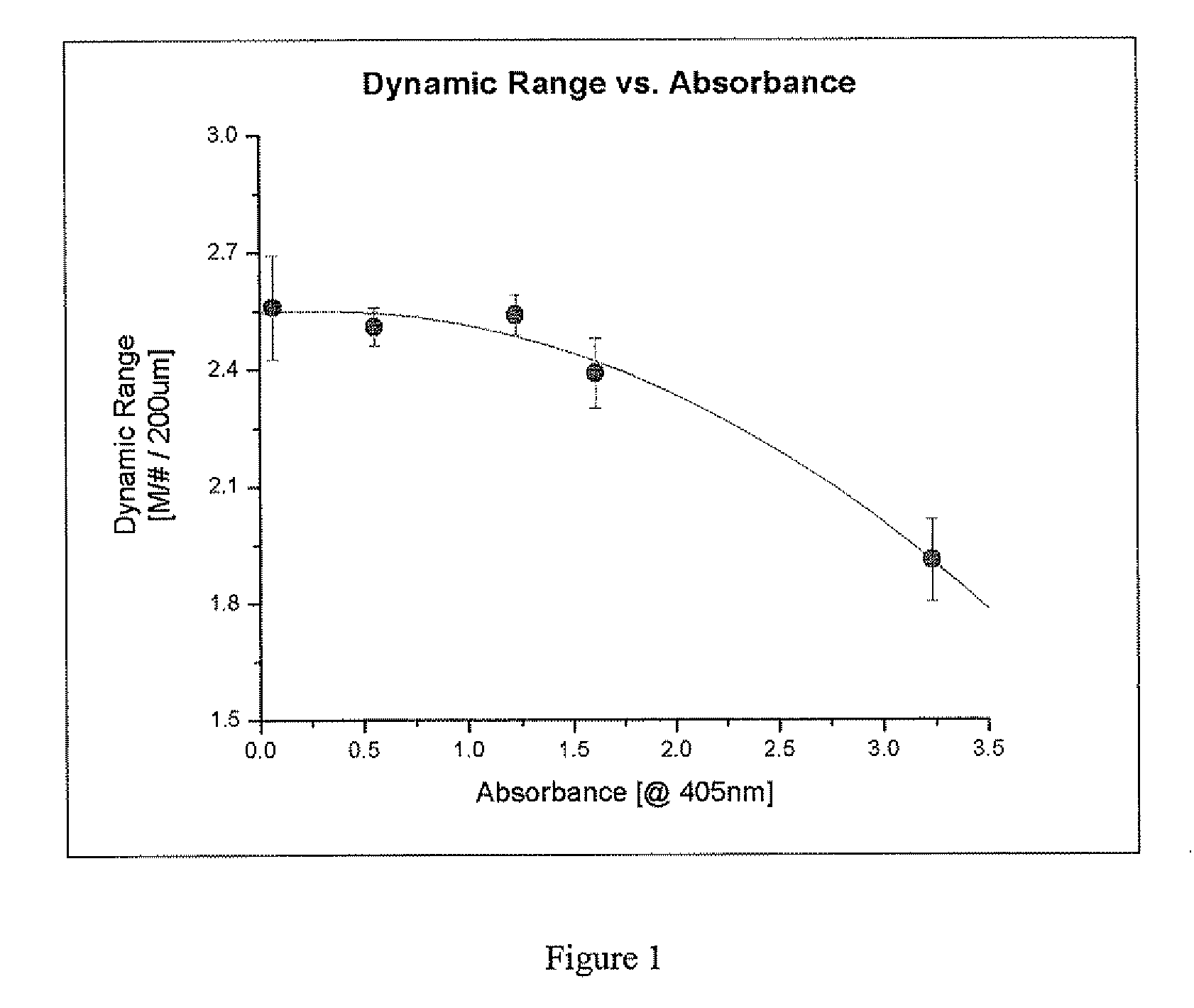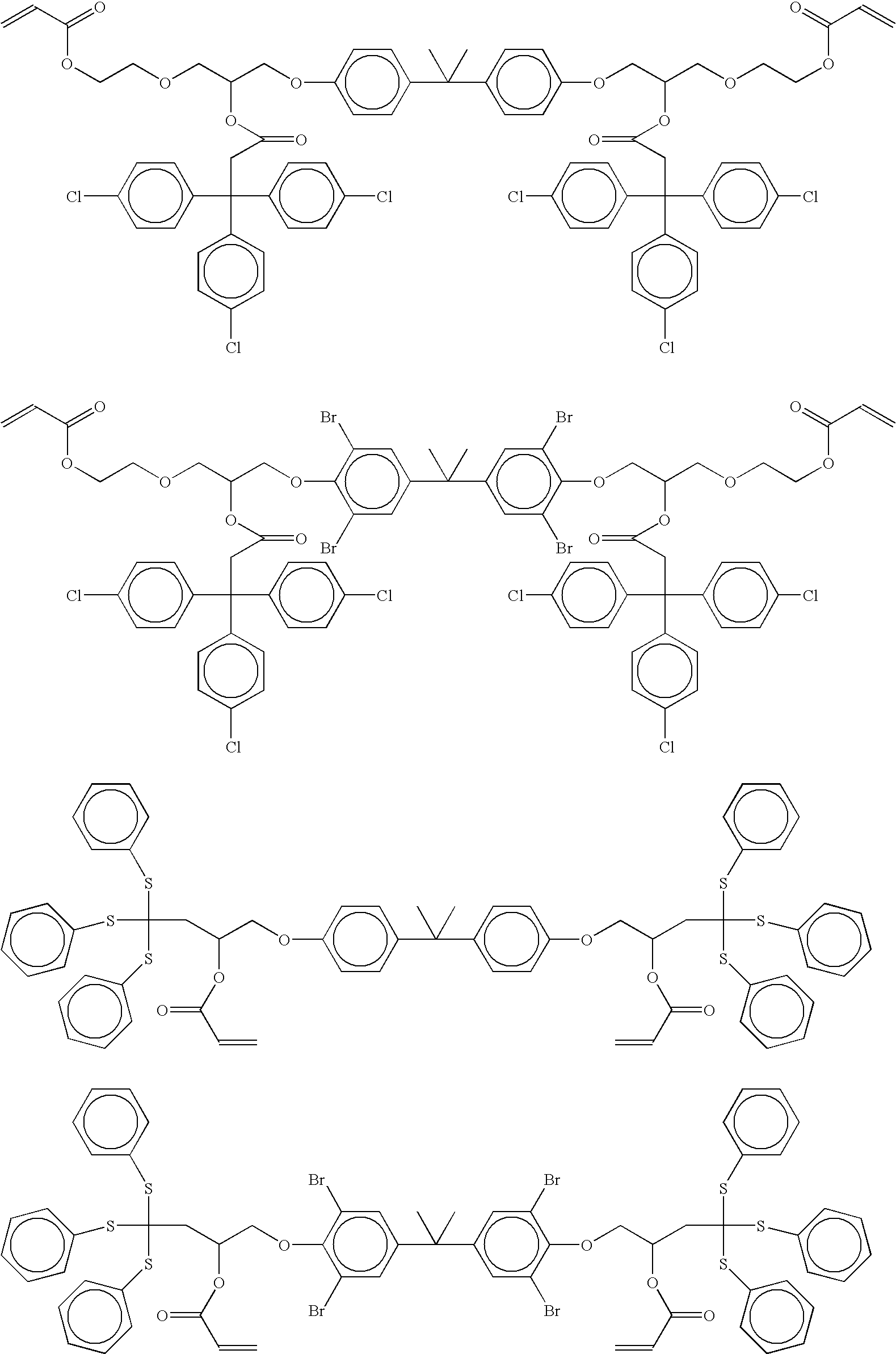Advantageous recording media for holographic applications
a technology of holographic applications and recording media, applied in the field of high-performance photopolymerizable recording materials, can solve the problems of less optimal characteristics and capabilities of holographic media to record and/or read data, and achieve the effects of improving the performance of photoactive monomers, high dynamic range, and high diffraction efficiency
- Summary
- Abstract
- Description
- Claims
- Application Information
AI Technical Summary
Benefits of technology
Problems solved by technology
Method used
Image
Examples
example 1
[0090]The holographic performances of two different formulations—one with a relatively low molecular weight monomer and the other with a high molecular weight monomer—are compared. The weight percents of the photoactive monomers are adjusted so that comparable number of moles of the monomer used.
TABLE 1Monomer A:Monomer B:Formulation 1Formulation 2-comparativeComponent / ParameterAccording to the InventionExamples, not according to the inventionA glycerole propoxylate with an65.73 wt %61.47 wt %average of Mn 1500Baytech WE 18030.31 wt %28.34 wt %Monomer A 2.66 wt %Monomer B 8.95 wt %Irgacure OXE01 0.30 wt % 0.30 wt %Dibutyltin Dilaurate-Catalyst 1.00 wt % 0.94 wt %M / # per 200 um11.275.3Refractive index adjusted5.3 × 10−62.1 × 10−6photosensitivityBaytech WE 180 is a Diphenylmethandiisocyanate based Polypropylenoxidepolyether prepolymer with a NCO-Gehalt of 18.6%; available form Bayer MaterialScience LLC, Pittsburgh, PA, USA.Irgacure OXE01 is a photoinitiator, available from Ciba Specia...
example 2
[0091]The holographic performance of formulations with varying optical densities are compared. The formulations contained:
Formulation 1:
[0092]Varying amounts wt % Darocur TPO
5.00 wt % Monomer A
0.11 wt % Benzhydrol
0.03 wt % Hydroxypropylacrylate
29.4 wt % Desmodur XP2410
25.7 wt % Polycaprolacton (Mw of app. 750)
[0093]Darocur TPO is 2,4,6-Trimethyl-benzoyl-diphenylphosphinoxid, available from Ciba Speciality Chemicals.
[0094]Desmodur XP2410 is a Hexanediisocyanate-1,6based polyisocyanate with an NCO content of 23.5%, containing a high content of oxadiazinedione structures, available from Bayer Material Science AG, Leverkusen, Germany.
[0095]The above example demonstrates the advantages of controlling the absorbance of the media to a value below at least 1.0.
Blockcopolymer 1:
[0096]A 1 liter three neck flask was charged with 0.25 g stannous octoate, 172.29 g {tilde over (□)} Caprolacton and 327.46 g of a difunctional Polytetrahydrofuranpolyetherpolyols (Equivalent weight 325 g / Mol OH) and ...
example 3
[0098]The holographic performances of four different formulations with differing ratios of the hydroxyl functionality of the polyol component to the isocyanate functionality of the NCO-terminated pre-polymer component. The formulations and performance characteristics of the different recording media are shown in Table 2.
TABLE 2Component / ParameterFormulation 1Formulation 2Formulation 3Formulation 4Blockcopolymer 210% excess20% excess30% excessDesmodur XP2410Monomer A8 wt %8 wt %8 wt %8 wt %TPO photoinitiator1500150015001500(ppm)Benzhydrol (ppm)5000500050005000Dibutyltin Dilaurate4 × 10−3 wt %4 × 10−3 wt %4 × 10−3 wt %4 × 10−3 wt %CatalystM / #per 200 um10.210.610.210.4Refractive index17.80 × 10−628.30 × 10−632.6 × 10−639.20 × 10−6adjustedphotosensitivity
[0099]The above example demonstrates the advantages of using an excess amount of the polyol component to improve the photosensitivity of the material. An upper limit on the amount of excess is typically determined to optimize the mechan...
PUM
| Property | Measurement | Unit |
|---|---|---|
| refractive index | aaaaa | aaaaa |
| shrinkage | aaaaa | aaaaa |
| boiling points | aaaaa | aaaaa |
Abstract
Description
Claims
Application Information
 Login to View More
Login to View More - R&D
- Intellectual Property
- Life Sciences
- Materials
- Tech Scout
- Unparalleled Data Quality
- Higher Quality Content
- 60% Fewer Hallucinations
Browse by: Latest US Patents, China's latest patents, Technical Efficacy Thesaurus, Application Domain, Technology Topic, Popular Technical Reports.
© 2025 PatSnap. All rights reserved.Legal|Privacy policy|Modern Slavery Act Transparency Statement|Sitemap|About US| Contact US: help@patsnap.com



